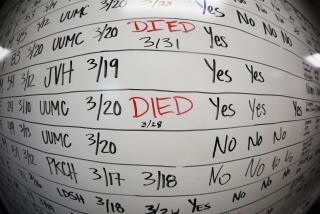Census Bureau’s Season of Giving Out Data Is Here
- Share via
WASHINGTON — It spent millions on advertising, hired temporary workers to knock on strangers’ doors and weathered its share of political controversy. Now the Census Bureau is poised to release figures that will remake the congressional map and document the changing population.
The first results from the 2000 census, to be released Thursday, are raw, state population totals. They are expected to confirm trends that estimates have hinted at since the last census a decade ago: booming populations in the South and West, slower growth in the North and Midwest.
That report will be followed by more detailed statistics in March, which will reveal America’s new racial makeup. The 2000 questionnaires allowed people for the first time to check off if they were of more than one race, providing a rich portrait of racial identification never before available.
These numbers will have complex political implications. The Supreme Court ruled last year that the raw, state data will be used to reapportion the 435 seats in the House among the 50 states.
The March report may include two sets of numbers: the raw figures and a second set adjusted by way of a statistical method known as sampling. The same court decision left it to states to decide which numbers to use when they redraw congressional and state legislative lines beginning next year.
But first, the incoming Bush administration will have to decide whether to even release the adjusted numbers, which many believe will help Democrats. President-elect George W. Bush hasn’t said what he will do.
Dig past the political implications, though, and Census Director Kenneth Prewitt believes the results will yield a demographic portrait of America as complex and diverse as ever. More detailed statistics will be released incrementally over the next two years, with topics ranging from poverty and income to immigration and same-sex-couple households.
Earlier in the year, some of the 120 million mailings sent to Americans to remind them of the count were mis-addressed because of a printing error. Some congressional Republicans questioned the intrusiveness of some questions on the 53-item long-form: “How much money do you make?” or “Do you have plumbing at home?”
The public weighed in, causing some problems for part-time census workers hired to go door to door to ask the questions.
“You would think it would be the income questions, but the one I heard the most flak about was about how many toilets you had in your house,” said Michael Zdan of Wilkes-Barre, Pa., who worked for the Census Bureau over the spring and summer.
But Prewitt said he remains optimistic about the overall prospects of success because more than 80 million, or about 67%, of the 120 million forms sent out, were returned. That reversed a decades-long decline in participation. Also, it left just 40 million households to track down with door-to-door visits, a far smaller workload than the Census Bureau expected.
Throughout the year, both political parties bickered over sampling, implemented after the Census Bureau estimated it undercounted about 1.4% of the population in 1990, mostly children, the poor, minorities and urban residents.
Inez Manion of Rhododendron, Ore., a retired translator who worked part time for the Census Bureau this year, ignores the political talk. She just wants to see some of the final answers to the questions she asked at the front doors of strangers’ homes.
More to Read
Get the L.A. Times Politics newsletter
Deeply reported insights into legislation, politics and policy from Sacramento, Washington and beyond. In your inbox twice per week.
You may occasionally receive promotional content from the Los Angeles Times.









